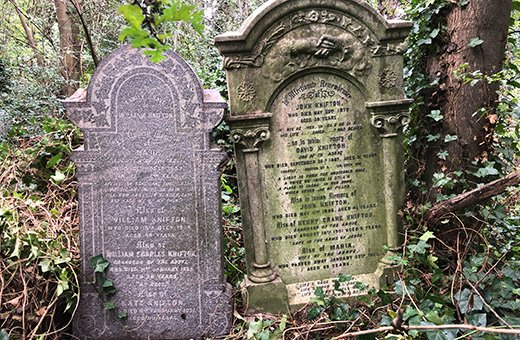John 'Jack' Knifton
Buried: 12/05/1896, aged 41
Plot no: 65850 | Section: K08 / A2
John Jack’s father, John Knifton Senior (c1820-1879) was born in Belton, Leicestershire. In the 1841 census he is shown as living in London in the parish of St Luke, Finsbury, with his occupation listed as ‘farmer’. In 1854 he married Maria Johnston (d. 1903), from Melrose, Scotland, in the parish of St John, Hoxton. At some time prior to 1861 they joined the migration of people in search of work and opportunity in London. (From 1841 to 1900, the population of London grew from almost 2 million to over 6 million.)
The 1861 census shows John and Maria living at 30 Bartholomew Place in the parish of St John, Hackney. From 1861 – 1871 John Knifton Snr’s occupation is listed as ‘cow keeper’. At this time there were many cow-keepers in Hackney and most of them kept their cattle in yards and sheds at their houses. With the growth of public health regulations, the number of licensed cowsheds fell from 83 in 1876 to 39 in 1900. He lived at 17 Hertford Road when he died, leaving Maria £800. (Valued at £110,492 in 2022.)
Born in 1855 John ‘Jack’ Knifton was the eldest of 9 children and his place of birth is sometimes noted as Shoreditch and sometimes as Scotland. Jack married Ann Ellis in 1875.
Jack initially followed his father’s occupation of cow-keeping. One of his sons, Augustus (born 1887) in an interview published in the UK Data Service project, ‘Family Life and Work Experience Before 1918, 1870-1973’ talks about the small house on Britannia Street, Hoxton where they lived.
‘There was a shop in the house where Ann sold dairy products; there was also a large cowshed below the shop holding 15 cows. They had a horse and cart which John took round selling the dairy products. The cattle were driven up and down the street once a week for exercise and washed down every day.’
Jack then moved on to become a bailiff and also ran an antiques shop before becoming the licensed victualler and proprietor of the London Assurance on City Road shortly before his death, for which he had paid £4,000. It was here that he hosted lavish meals for his family and friends who included Freemasons and Lord Claud Hamilton.
© unknown. No copyright infringement intended.
Jack also attended meetings of the East Finsbury Radical Club, and contributed to their soup kitchen for the poor and to the cabmen in their 1894 strike over working conditions. His son believed his father became more conservative towards the end of his life although he had friends on both sides of the political divide, and across the social classes.
Jack described himself as a Vestryman and Guardian of the Parish where he had lived from boyhood. Records show that John was admitted to Pimlico Lodge of Freemasons on 5th November 1895, a few months before his death.
Jack was described as a good sportsman, showing skill as a swordsman, swimmer, runner, Highland Fling dancer, as well as boxer. Earlier in his boxing career he would box rounds against his brother David (d1887). There were several unsuccessful attempts in 1886 to stage a championship match with Jem Smith (fought his first bare-knuckle prize fight in 1881, later became a heavyweight champion in 1886). They even travelled to Paris for an aborted match and faced prosecution for another attempt in London. After stepping down from boxing, Jack still participated in sparring exhibitions, and was the Master of Ceremony at public events.
© unknown. No copyright infringement intended.
Jack was buried at Abney Park Cemetery on 12th May 1896, sharing a grave with his father (John), his mother (Maria), brother (David), and his nephew (Henry Crane, son of Charles Knifton.) The National Probate Register lists his effects as being under £10.
Augustus describes a secure and loving family life - they always were clothed and fed properly, they were never hit, they were encouraged to learn, and to treat all people well. He talks of both his parents with fondness. He also remembers his mother playing the piano a lot. He believes his father may have died of kidney damage caused by severe blows and describes it as ‘a shocking death’.
Augustus also describes his father’s funeral as a large one with a procession that stretched from City Road through to Old Street and then up to Shoreditch. The Salvation Army Band and the East Finsbury Radical Club Band played in the procession which included 95 empty hansom cabs. A ‘monster’ wreath was sent from the drivers of the North London Branch of the L.C.D.T.C. in recognition of his charitable support. No women went to the funeral.
Jack's friends, particularly Henry Richards, Conservative MP for Finsbury East, helped the family out with the disposal of the business, admission to good schools and occupations. Several of the children were sent to live with relatives during the period after his death. Augustus believed his father’s parents (this must mean Henry Crane and Maria) also assisted them as they now lived close by in Stoke Newington.
From the 1901 and 1911 census records, Ann (Jack’s widow) and her family lived in a 6-room house at 87 Listria Park. The 1911 entry for Ann Knifton shows that they had 13 children, 8 of whom were alive at the time of his death.
An article in the South Wales Daily News - Wednesday 08 September 1886, page 4 (edited)
The Coming Fight for the Championship - Interview with John Knifton, the ‘Eighty-One Tonner’
John Knifton, the unbeaten champion prize-fighter, is shortly to meet Jim Smith, the champion of England, to decide definitely who really has the better title to the name. Bearing this in mind, a London commissioner lately sought and obtained an interview with Knifton, who, in a courteous manner, gave every information required. Knifton is a cowkeeper, and supplies his neighbourhood with milk from the 15 or 20 cows which he possesses. He works steadily at his business, which brings in sufficient to keep him and his family in easy circumstances. Knifton does
not mind this being known, because it is evidence of what he is constantly repeating, viz., that when he fights it is for honour and glory, and not for the sake of making a living out of it. Thus much by way of introduction.
In the course of conversation Knifton said :— ”I expect my fighting weight will be 14st, or a little over. My height is 6ft lin., and I am about 30 years of age. At 14 I joined the 2nd Life Guards, and remained two years in the regiment. During that time I was champion runner and jumper in the sports at Burleigh Bottom, and defeated all comers in boxing and wrestling. In high jumping I could clear six feet. With the foils and in single-stick exercise few could beat me and I was equally good with sword and lance, on foot or mounted. I assisted in giving Baron Leopold Rothschild lessons in these and other exercises. At the marriage of Princess Louise, at Windsor Castle, I was one of the advanced guards. A ludicrous incident occurred in connection with this, for we lost the carriages containing the newly married couple. Another feat that I was at that time able to perform was to vault straight into the saddle fully accoutred."
We rose to leave, and at the door made some remark about the coming encounter with Jim Smith. “Ah," said Knifton in a jovial tone, “I am all right now, and feel confident as to the result of our meeting. Yes, on the day I fight Jim Smith I hope to be as fit and well as ever a man can be." With these words our interview concluded.
We came away thinking of the strangeness of the things on this planet. Here was a man who to the world is known as a prize-fighter, and yet, when at home, is engaged in the peaceful occupation of keeping cows and selling milk; here was a man who is a kind and considerate husband and father, a benefactor to the poor in his parish, with a great deal of refinement in his character, who, nevertheless, at the mention of fighting (which to him is as a red rag to a bull), becomes the pugnacious pugilist, ready for a bit of sparring at a moment's notice.
Little do the inhabitants of London think that one of the most persistent agitators and energetic workers in the cause of the lads was the undefeated ‘81-tonner’.
The epitaph at the foot of the headstone.





